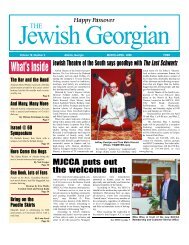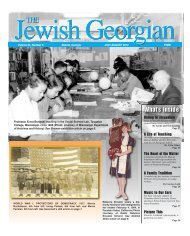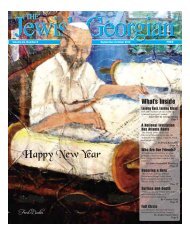JGA July-August 09 - The Jewish Georgian
JGA July-August 09 - The Jewish Georgian
JGA July-August 09 - The Jewish Georgian
Create successful ePaper yourself
Turn your PDF publications into a flip-book with our unique Google optimized e-Paper software.
<strong>July</strong>-<strong>August</strong> 20<strong>09</strong> THE JEWISH GEORGIAN Page 11<br />
Dachau Artist Colony exhibition continues at Oglethorpe<br />
T<br />
he groundbreaking exhibitions<br />
“Dachau Before Dachau: European<br />
Artist Colony 1860-1914” and<br />
“Dachau Concentration Camp: Years of<br />
Destruction 1933-1945” are at the<br />
Oglethorpe University Museum of Art<br />
(OUMA) through <strong>August</strong> 30.<br />
When Chloe Edwards, president<br />
of Oglethorpe’s <strong>Jewish</strong> Student Union,<br />
first heard that the exhibition was coming<br />
to the school, she “was intrigued but also<br />
apprehensive, “ she wrote in the <strong>The</strong><br />
Stormy Petrel, the student newspaper.<br />
“What could this mean to me, as a Jew and<br />
the current president of the <strong>Jewish</strong> Student<br />
Union, and also as an art lover, someone<br />
who attends the opening of new OUMA<br />
exhibits religiously each semester? Could<br />
I, in good conscience, attend this exhibit,<br />
let alone endorse it? While I have heard<br />
arguments for supporting and shunning<br />
the Dachau exhibit, having thought long<br />
and hard about it, I find that I must support<br />
the efforts of the museum in bringing<br />
this exhibit to campus. “<br />
<strong>The</strong> following essays are reprinted,<br />
with permission, from the exhibition catalogue<br />
accompany the Dachau Artist<br />
Colony exhibition at the OUMA.<br />
—————<br />
It was during the twentieth century<br />
that the name “Dachau” became famous<br />
throughout Europe and the world in association<br />
with horror. For Dachau was the<br />
location of the concentration camp that<br />
bore the city’s name from the very beginning.<br />
<strong>The</strong> name “Dachau” will always go<br />
hand in hand with memories of the<br />
National Socialist crimes against humanity,<br />
a circumstance placing a special<br />
responsibility on the city which it must—<br />
and will—never evade. This responsibility<br />
means, among other things, that Dachau<br />
must do everything in its power to ensure<br />
that the memory of the abominable crimes<br />
of National Socialism is kept alive for the<br />
generations that did not witness the events<br />
first-hand. <strong>The</strong> first and foremost obligation<br />
assigned the city of Dachau by its<br />
own history is to be a city of peace and a<br />
place of learning and commemoration for<br />
the world’s youth.<br />
As a site of remembrance, Dachau<br />
actively confronts its history. One concrete<br />
expression of this is the Dachau<br />
Youth Guesthouse, which invites young<br />
people from Germany and abroad to study<br />
National Socialist despotism and organizes<br />
discussions with persons who experienced<br />
the historical events. <strong>The</strong> town has<br />
furthermore established a Department of<br />
Contemporary History in addition to hosting<br />
an annual symposium on the same<br />
subject.<br />
Yet Dachau was and is also a city of<br />
culture. Already in the late nineteenth century,<br />
due to its proximity to Munich, one<br />
of the most important artists’ colonies of<br />
Europe emerged here. Attracted by the<br />
fascinating landscape of the Dachau<br />
Moor, a substantial number of artists—<br />
Adolf Hoelzel, Ludwig Dill, Arthur<br />
Langhammer, and others—moved to<br />
Dachau. And thanks to the unusually large<br />
number of artists presently living and<br />
working here, the city is still a vibrant<br />
artists’ centre today. What is more,<br />
Dachau has become increasingly active in<br />
the Federation of European Artists’<br />
Colonies EuroArt.<br />
In the coming years, by means of a<br />
traveling exhibition in English, Dachau<br />
would like to introduce itself internationally<br />
as a place of commemoration and culture.<br />
In the process, it will decidedly not<br />
use culture as a means of distracting from<br />
the city’s history. On the contrary: the city<br />
of Dachau wants to show how important<br />
the interplay of commemoration and culture<br />
is for a peaceful and open world.<br />
In Dachau, culture and commemoration<br />
are inseparable. Along with the city’s<br />
active commemoration and remembrance<br />
work, art and culture serve as responses to<br />
its history and act as its ambassadors to<br />
the world. <strong>The</strong> city of Dachau, whose<br />
name has become synonymous with the<br />
atrocities committed during the Third<br />
Reich, is opening its doors and presenting<br />
itself to the world as a cosmopolitan and<br />
international city of culture.<br />
—Peter Bürgel, Mayor, City of Dachau<br />
—————-<br />
<strong>The</strong> Artists of Dachau<br />
<strong>The</strong> Dachau Painting Gallery is situated<br />
in the middle of the picturesque historic<br />
city of Dachau, right opposite the city<br />
hall. Its permanent collection provides<br />
documentary evidence of the artists’<br />
movement in the 19th century, which gave<br />
an important stimulus to the development<br />
of art in Germany. It was here in Dachau<br />
that the open-air painting found one of its<br />
origins, the discovery of the landscape as<br />
an independent motif.<br />
Due to its location in the vicinity of<br />
Munich, Dachau became a popular meeting<br />
point for landscape painters in the 19th<br />
century. First, they were enthusiastic<br />
about the atmospheric landscape of the<br />
Dachau Moss, with its changing natural<br />
light. Later, the painters began to show<br />
interest in the picturesque city, the village<br />
life, and the people in their traditional costumes.<br />
Besides purely artistic reasons<br />
which made the landscape painters leave<br />
the Munich art scene and go to Dachau,<br />
some of them came because of economic<br />
considerations. In comparison to Munich,<br />
living in Dachau was cheaper and the<br />
rents for studios were reasonable. Dachau<br />
became an artists’ location where the<br />
painters tried to portray the landscape in a<br />
true-to-life way. This was successfully<br />
achieved by painting right in front of the<br />
motif, in the landscape itself. Nature had<br />
become a work of art.<br />
<strong>The</strong> Dachau Moss (or moor) was discovered<br />
in the first half of the nineteenth<br />
Gustav Keller (1860-1911),<br />
Heimweg/Way home, oil on<br />
cardboard, 28 x 34.5 cm<br />
Museumsverein Dachau<br />
century, by Johann Georg von Dillis, who<br />
was a teacher in landscape painting at the<br />
Munich Academy from 1804 to 1814. He<br />
visited the Dachau Moss together with his<br />
students and encouraged them to paint<br />
from nature. It was only in the middle of<br />
the nineteenth century that artists like<br />
Eduard Schleich the Older, Carl Spitzweg,<br />
and Christian Morgenstern came to<br />
Dachau. <strong>The</strong>y were strongly influenced by<br />
the artists from Barbizon, whom they had<br />
visited in 1851. <strong>The</strong> style in painting of<br />
the second half of the century was characterized<br />
by Adolf Lier and Wilhelm von<br />
Diez, two famous teachers in landscape<br />
painting at the Munich Academy. Among<br />
their students were painters like Fritz<br />
Baer, Josua von Gietl, Richard von<br />
Poschinger, Joseph Wenglein, Ludwig<br />
Willroider, Hans am Ende, Ludwig<br />
Herterich, Fritz Mackensen, Max Slevogt,<br />
and Wilhelm Trübner.<br />
Around 1900, Dachau became an<br />
artistic colony through the work of art of<br />
Ludwig Dill, Adolf Hölzel, and Arthur<br />
Langhammer and an art center from which<br />
an important new style developed. From<br />
Hans von Hayek<br />
(1869-1940),<br />
Verschneiter Bauernhof/Snow<br />
Covered Farm, 1904, oil on<br />
canvas, 60.5 x 80 cm<br />
Stadt Dachau<br />
Otto Rau (1869 – 1900s),<br />
Winterlandschaft/Wintery<br />
Landscape, oil on canvas,<br />
49.5 x 65.7 cm<br />
Dachauer Galerien und<br />
Museen<br />
Dr. Ulrich und Gertrude<br />
Lechner Stiftung<br />
1893 until 1905, they met in Dachau to<br />
discover new styles in painting and<br />
expressions. <strong>The</strong>ir breakthrough came in<br />
1898, when the three artists had a joint<br />
exhibition as “<strong>The</strong> Dachauer“ in Berlin.<br />
With the outbreak of World War I in 1914,<br />
Dachau, as many other artistic colonies,<br />
lost its importance. New, sensational fashions<br />
in painting were created in the big<br />
cities, and only a small group of painters<br />
remained in Dachau. Nevertheless,<br />
besides the traditional open-air painting<br />
which still was continued by some artists,<br />
there were also avant-garde-style painters<br />
in Dachau, like <strong>August</strong> Kallert, Adolf<br />
Schinnerer, and Paula Wimmer, all artists<br />
who were looking for development out of<br />
the regional boundaries.<br />
OUMA is located on the campus of<br />
Oglethorpe University, 4484 Peachtree<br />
Road N. E. Hours are 12:00 noon-5:00<br />
p.m., Tuesday-Sunday. Admission is $5.<br />
For additional information, visit<br />
http://museum.oglethorpe.edu, or call<br />
404-364-8555.
















